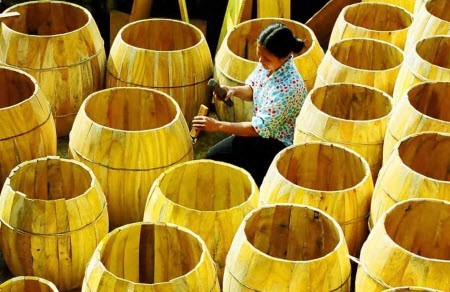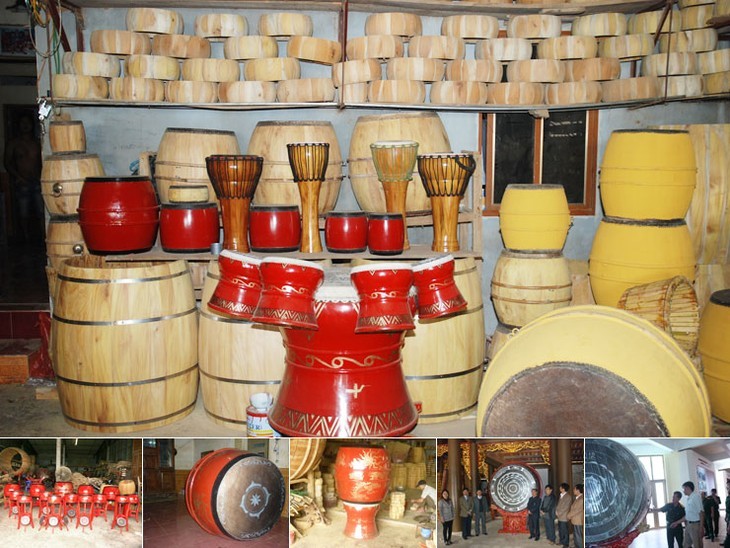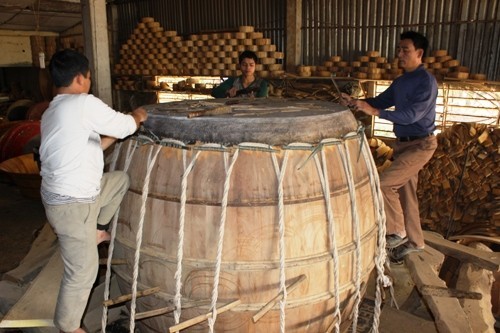Are you fascinated by the rich cultural tapestry of Vietnam and curious about the traditional crafts it holds? Discover the captivating world of Doi Tam drum making, where ancient techniques and cultural significance intertwine. SIXT.VN is here to guide you through this unique Vietnamese art form, offering insights and travel tips for your cultural exploration. Experience the heart of Vietnamese heritage with authentic drums and cultural performances.
1. What Makes Doi Tam Village a Special Place for Traditional Vietnamese Drums?
Doi Tam Village, nestled at the foot of scenic Doi Mountain in Ha Nam province, Vietnam, is renowned for its centuries-old tradition of crafting traditional Vietnamese drums. Its history stretches back over 1,000 years, with drum making deeply embedded in the village’s cultural identity. This long-standing heritage, combined with unique techniques passed down through generations, distinguishes Doi Tam as a prominent center for drum production in Vietnam.
1.1. A Legacy of Craftsmanship
The craft’s origin is attributed to Nguyen Duc Nang, who, in 987, created a giant drum for King Le Dai Hanh’s ploughing ceremony. The drum’s thunderous sound earned Nang the title “Master of Thunder,” solidifying Doi Tam’s reputation for exceptional drum making. According to historical accounts, this event marked the beginning of Doi Tam’s journey as a specialized drum-making village.
 Nguyen Duc Nang, the founder of Doi Tam drum making village
Nguyen Duc Nang, the founder of Doi Tam drum making village
1.2. Unique Techniques and Village Secrets
Doi Tam’s drum makers possess specialized techniques and closely guarded secrets that contribute to the unique sound and quality of their drums. Artisan Pham Chi Khang emphasized the importance of precision in assembling the drum barrel, a process considered a “village secret.” The village’s craftsmanship is so distinctive that, in 2007, Doi Tam was recognized as one of Vietnam’s “outstanding craft villages” by the Vietnam Craft Village Association.
1.3. Cultural Significance
Drums in Doi Tam are not merely musical instruments; they are integral to Vietnamese culture, used in various ceremonies, festivals, and spiritual rites. Tran Dinh Tien, head of the Culture and Information Section in Duy Tien district, noted that drums invite people to participate in community activities and “wake up spirits” during festivals. The drums resonate with cultural significance, serving as a call to arms, an announcement of mourning, or a mark of respect in performances.
2. What are the Different Types of Traditional Vietnamese Drums Made in Doi Tam?
Doi Tam Village produces a wide array of traditional Vietnamese drums, each designed for specific purposes and occasions. From small drums used in Cheo singing to large drums for festivals and spiritual ceremonies, the village’s craftsmen create instruments that cater to diverse cultural needs. According to artisan Khang, they produce about 25 types of drums, each with unique characteristics.
2.1. Drums for Rituals and Spiritual Rites
Spiritual or worship drums are crafted for rituals and sacrifice offering rites. These drums hold deep spiritual meaning and are used in religious ceremonies to connect with the divine.
2.2. Festival Drums
Festival drums are designed for community festivals and celebrations. These drums are typically larger and produce vibrant sounds that energize and engage participants. As Khang mentioned, festival drums often feature cloud patterns, symbolizing the festive atmosphere.
2.3. Temple, Pagoda, and Communal House Drums
Doi Tam also produces drums specifically for temples, pagodas, and communal houses. The size and sound of these drums vary depending on the specific purpose and the deity or spirit being honored. For instance, drums in communal houses are large, representing the tutelary god of the village, while pagoda drums can be smaller.
 Various sizes and types of drums made in Doi Tam village
Various sizes and types of drums made in Doi Tam village
2.4. Drums for Performances
Drums are also essential in traditional Vietnamese performances, such as Cheo and Ca tru. In these art forms, drums provide rhythmic accompaniment and enhance the overall artistic experience. Connoisseurs often use drumsticks to knock against the side of the drum to show appreciation during performances.
3. What is the Process of Making Traditional Vietnamese Drums in Doi Tam?
The creation of traditional Vietnamese drums in Doi Tam involves a meticulous three-stage process: leather tanning, drum-barrel making, and drumhead stretching. Each stage requires precision, expertise, and a deep understanding of the materials to achieve the desired sound quality. According to artisan Khang, the process demands skill and attention to detail at every step.
3.1. Leather Tanning
The first step involves preparing the buffalo skin, which is used to make the drumhead. Craftsmen carefully shave the buffalo leather until it becomes very thin and then dry it in the sun. This process ensures that the drumhead is both durable and capable of producing a resonant sound.
3.2. Drum-Barrel Making
The drum barrel is made from dried jackfruit wood, known for its durability and acoustic properties. Skilled artisans assemble the barrel with precision, ensuring that it is perfectly shaped to produce the desired sound.
 Assembling a drum barrel at Doi Tam village
Assembling a drum barrel at Doi Tam village
3.3. Drumhead Stretching
The most challenging stage is stretching the drumhead, as it requires the artisan to assess the sound and make precise adjustments. This step determines the drum’s final tone and resonance. The drumhead must be stretched evenly and tightly to achieve the perfect sound.
 Drumhead stretching in Doi Tam
Drumhead stretching in Doi Tam
4. What Materials are Used to Make Traditional Vietnamese Drums in Doi Tam?
Traditional Vietnamese drums made in Doi Tam are crafted using specific materials chosen for their acoustic properties and durability. The primary materials include buffalo skin for the drumhead and jackfruit wood for the drum barrel. These materials, combined with the artisan’s skill, ensure that each drum produces a distinctive and resonant sound.
4.1. Buffalo Skin
Buffalo skin is the preferred material for drumheads due to its strength and ability to produce a deep, resonant sound. The skin is carefully tanned and prepared to ensure optimal sound quality.
4.2. Jackfruit Wood
Jackfruit wood is used for the drum barrel because it is durable and possesses excellent acoustic properties. The wood is dried and shaped with precision to create the perfect resonating chamber for the drum.
4.3. Other Materials
In addition to buffalo skin and jackfruit wood, other materials such as nails, glue, and decorative elements are used to complete the drum. These materials are selected for their quality and compatibility with the primary materials.
5. What is the Significance of Drum Patterns and Decorations in Doi Tam?
The patterns and decorations on traditional Vietnamese drums in Doi Tam are not merely aesthetic; they carry symbolic meanings that reflect the drum’s purpose and cultural context. According to artisan Khang, the patterns depend on the drum’s purpose, with different designs used for festival drums, temple drums, and other types of drums.
5.1. Patterns for Festival Drums
Festival drums often feature cloud patterns, symbolizing celebration and joy. These designs add to the festive atmosphere and reflect the drum’s role in community events.
5.2. Patterns for Temple and Communal House Drums
Temple and communal house drums typically feature dragon-shaped clouds or phoenixes, symbolizing power, protection, and spiritual significance. These patterns honor the deities and spirits associated with the temple or communal house.
5.3. Patterns for Art Troupes
Drums used by art troupes are often decorated with brocade designs or motifs similar to those found on bronze drums. These patterns reflect the artistic and cultural heritage of the performance.
5.4. Patterns for Cultural Events
Drums for cultural events are often decorated with cranes, symbolizing longevity and good fortune. These designs add to the drum’s visual appeal and convey positive messages.
5.5. Light Rays
Drumheads of festival drums often feature light rays spreading out to symbolize the world. This design represents the drum’s role in bringing people together and celebrating life.
6. How Does Doi Tam Village Preserve and Promote its Drum-Making Tradition?
Doi Tam Village actively works to preserve and promote its drum-making tradition through various initiatives, including training younger generations, forming drumming teams, and participating in cultural events. The village’s commitment to preserving its heritage ensures that the art of drum making continues to thrive. Le Ngoc Minh, the village chief, emphasized the village’s dedication to preserving the craft and ensuring its prosperity.
6.1. Training Younger Generations
передают секреты мастерства из поколения в поколение, обучая молодых людей техникам изготовления барабанов. This ensures that the knowledge and skills required to make high-quality drums are passed down, maintaining the village’s legacy.
6.2. Drumming Teams
Doi Tam has formed a 60-member drumming team that performs at festivals nationwide. The team includes both men and women who play drums and other traditional instruments, showcasing the village’s cultural heritage and promoting its drum-making tradition.
 The Doi Tam female drummer team
The Doi Tam female drummer team
6.3. Participation in Cultural Events
Doi Tam actively participates in cultural events and festivals, both locally and nationally, to showcase its drum-making tradition. These events provide a platform for the village to promote its craft, attract visitors, and generate interest in its cultural heritage.
6.4. Supporting Local Artisans
The village supports local artisans by providing resources and opportunities to continue their craft. This includes access to materials, training programs, and marketing support to help artisans sell their drums and sustain their livelihoods.
7. What is the Role of Women in the Drum-Making Tradition of Doi Tam?
Women play a significant role in the drum-making tradition of Doi Tam, both as artisans and performers. They participate in all aspects of the craft, from leather tanning to drumhead stretching, and are also actively involved in drumming teams that perform at festivals and cultural events. Le Thi Thuy Thuong, a member of the drumming team, expressed her honor in contributing to the preservation of the traditional craft.
7.1. Female Artisans
Women in Doi Tam have mastered the art of drum making and are skilled in all stages of the process. They work alongside men to create high-quality drums and pass down their knowledge to younger generations.
7.2. Female Drummers
The Doi Tam drumming team includes 48 married women who play drums at festivals and cultural events. These women are passionate about preserving their cultural heritage and contribute to the vibrant sound and energy of the performances.
7.3. Promoting Cultural Heritage
By participating in drumming teams and cultural events, women in Doi Tam help promote their village’s drum-making tradition and cultural heritage. Their involvement ensures that the art of drum making continues to thrive and is celebrated by future generations.
8. How Can Tourists Experience the Drum-Making Tradition in Doi Tam?
Tourists can experience the drum-making tradition in Doi Tam by visiting the village, meeting local artisans, and participating in cultural events. This immersive experience offers a unique opportunity to learn about the history, techniques, and cultural significance of drum making in Vietnam. SIXT.VN can help you plan your visit and provide transportation and accommodation options.
8.1. Visiting Doi Tam Village
Doi Tam Village welcomes visitors who are interested in learning about its drum-making tradition. Tourists can explore the village, visit drum-making workshops, and meet local artisans to learn about the craft firsthand.
8.2. Meeting Local Artisans
Meeting local artisans provides an opportunity to learn about the techniques and cultural significance of drum making. Artisans are often willing to share their knowledge and demonstrate the process of creating a drum.
8.3. Participating in Cultural Events
Participating in cultural events and festivals in Doi Tam offers an immersive experience of the village’s drum-making tradition. Tourists can witness drumming performances, learn about traditional music, and experience the vibrant culture of the village.
8.4. Booking a Tour with SIXT.VN
SIXT.VN offers tours to Doi Tam Village, providing transportation, accommodation, and guided experiences. Our tours are designed to offer an immersive and authentic experience of the village’s drum-making tradition.
9. What are the Challenges Faced by Doi Tam Village in Maintaining its Tradition?
Doi Tam Village faces several challenges in maintaining its drum-making tradition, including competition from modern instruments, economic pressures, and the need to adapt to changing cultural preferences. Overcoming these challenges requires innovative strategies and a commitment to preserving the village’s cultural heritage.
9.1. Competition from Modern Instruments
The rise of modern musical instruments poses a challenge to the traditional drum-making industry. Modern instruments are often more affordable and accessible, making it difficult for traditional drum makers to compete.
9.2. Economic Pressures
Economic pressures, such as rising material costs and the need to generate income, can impact the sustainability of the drum-making tradition. Artisans may struggle to maintain their craft while meeting their financial needs.
9.3. Changing Cultural Preferences
Changing cultural preferences and the influence of globalization can lead to a decline in interest in traditional music and instruments. This can reduce demand for traditional drums and threaten the viability of the drum-making industry.
9.4. Ensuring Authenticity
Maintaining the authenticity of the drum-making tradition while adapting to modern demands is a challenge. It is important to preserve the traditional techniques and cultural significance of the craft while also innovating to meet the needs of contemporary customers.
10. How is SIXT.VN Supporting Cultural Tourism in Vietnam, Including Villages Like Doi Tam?
SIXT.VN is committed to supporting cultural tourism in Vietnam, including villages like Doi Tam, by providing transportation, accommodation, and guided experiences that promote cultural heritage and sustainable tourism practices. We work with local communities to ensure that tourism benefits the village and helps preserve its cultural traditions.
10.1. Providing Transportation
SIXT.VN offers transportation services to Doi Tam Village, making it easier for tourists to visit and experience the drum-making tradition. Our transportation options include private cars, buses, and vans, catering to individual travelers and groups.
10.2. Offering Accommodation
SIXT.VN provides accommodation options in and around Doi Tam Village, ranging from hotels to homestays. We work with local businesses to ensure that tourists have comfortable and authentic experiences.
10.3. Organizing Guided Tours
SIXT.VN organizes guided tours to Doi Tam Village, providing tourists with knowledgeable guides who can share insights into the history, techniques, and cultural significance of drum making. Our tours are designed to offer an immersive and enriching experience.
10.4. Promoting Sustainable Tourism
SIXT.VN is committed to promoting sustainable tourism practices that benefit local communities and preserve cultural heritage. We work with local businesses and organizations to ensure that tourism is responsible and contributes to the long-term well-being of the village.
10.5. Supporting Local Artisans
By promoting cultural tourism and bringing visitors to Doi Tam Village, SIXT.VN helps support local artisans and their craft. The increased demand for traditional drums and cultural experiences provides artisans with opportunities to sustain their livelihoods and preserve their cultural heritage.
Are you ready to embark on a cultural journey to Doi Tam Village? Let SIXT.VN be your trusted partner in exploring the rich traditions of Vietnam. With our reliable transportation, comfortable accommodations, and expert guidance, we ensure an unforgettable experience that celebrates the heart of Vietnamese heritage. Contact us today to plan your adventure and discover the magic of Doi Tam drum making.
Address: 260 Cau Giay, Hanoi, Vietnam
Hotline/Whatsapp: +84 986 244 358
Website: SIXT.VN
FAQ about Traditional Vietnamese Drums in Doi Tam
1. What is Doi Tam Village known for?
Doi Tam Village is famous for its centuries-old tradition of making traditional Vietnamese drums.
2. How old is the drum-making tradition in Doi Tam?
The drum-making tradition in Doi Tam dates back over 1,000 years.
3. What materials are used to make drums in Doi Tam?
Drums in Doi Tam are typically made from buffalo skin for the drumhead and jackfruit wood for the drum barrel.
4. What are the different types of drums made in Doi Tam?
Doi Tam produces various types of drums, including festival drums, temple drums, and drums for cultural performances.
5. How are drums decorated in Doi Tam?
Drums in Doi Tam are decorated with various patterns, such as clouds, dragons, and phoenixes, depending on their purpose.
6. How can I visit Doi Tam Village?
You can visit Doi Tam Village by booking a tour with SIXT.VN or arranging your own transportation.
7. What can I expect to see and do in Doi Tam?
In Doi Tam, you can visit drum-making workshops, meet local artisans, and witness drumming performances.
8. What is the role of women in the drum-making tradition in Doi Tam?
Women play a significant role in the drum-making tradition in Doi Tam as both artisans and performers.
9. How does Doi Tam preserve its drum-making tradition?
Doi Tam preserves its drum-making tradition by training younger generations and participating in cultural events.
10. How can SIXT.VN help me plan my trip to Doi Tam?
SIXT.VN can help you plan your trip to Doi Tam by providing transportation, accommodation, and guided tour options.



